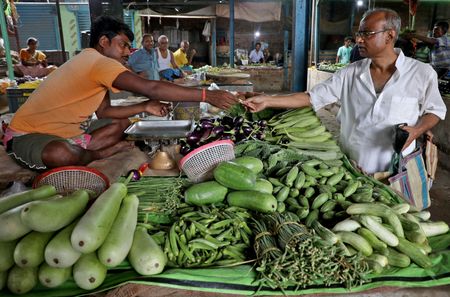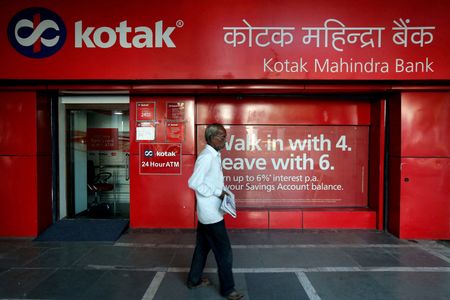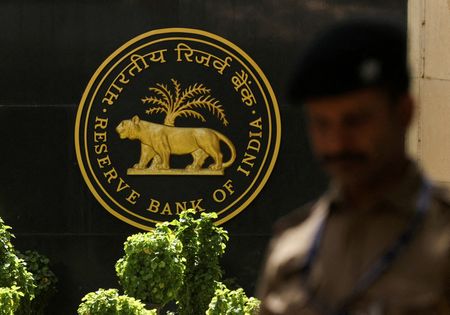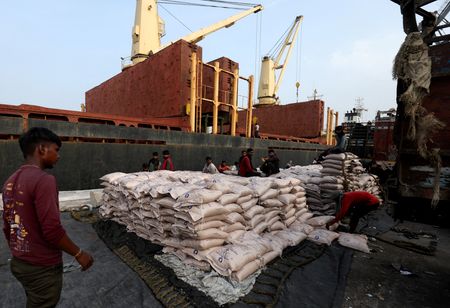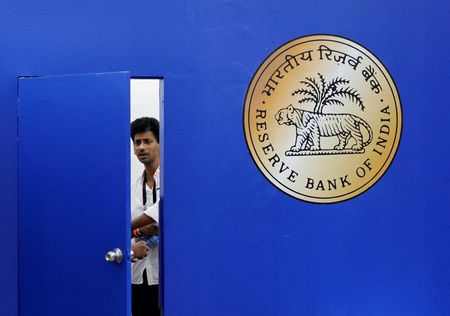(Reuters) – India’s retail inflation eased to a five-month low of 4.31% in January from 5.22% in December as food price inflation declined, government data released on Wednesday showed.
Annual retail inflation in January was lower than economists’ estimate of 4.6%.
HARRY CHAMBERS, ASSISTANT ECONOMIST, CAPITAL ECONOMICS, LONDON
“The sharp fall in Indian headline consumer price inflation in January reinforces our view that the RBI will continue to loosen monetary policy over the coming months to support the economy.”
“Looking ahead, good soil conditions, healthy reservoir levels and a high base means that we expect food inflation to continue slowing over the coming months. And with the economy in a softer patch, underlying price pressures should remain in check.”
“With inflation likely to fall a little further, and the central bank’s focus shifting to boosting economic growth, more monetary easing lies in store. We expect another 75bps of cuts over the rest of this year, bringing the repo rate down to 5.50%.”
RADHIKA RAO, SENIOR ECONOMIST, DBS BANK, SINGAPORE
“Softening inflation prints back the central bank MPC’s (Monetary Policy Committee) move to lower rates earlier in the month, with headline prints expected to head to and below the midpoint of the target over the next 2-3 months.”
“Monetary policy is expected to be focused on the domestic growth-inflation trade-off at this juncture, whilst addressing rupee depreciation risks via intervention efforts.”
DIPANWITA MAZUMDAR, ECONOMIST, BANK OF BARODA, MUMBAI
“The softening of CPI is welcoming from a policy standpoint when global uncertainty is at play. The downward correction is supported by food and rangebound commodity prices.”
“Going forward, better arrival statistics of vegetables, generous Rabi harvest and government efforts directed at efficient food supply management will further provide breather for RBI.”
“However, risks emerge from imported inflation and bottoming out of commodity price cycle.”
UPASNA BHARDWAJ, CHIEF ECONOMIST, KOTAK MAHINDRA BANK, MUMBAI
“January CPI inflation moderated sharper than expected, led by significant easing of food prices. Meanwhile, core inflation inched up a bit to 3.7%.”
“Overall, we expect the inflation trajectory to remain benign in the months ahead to provide room for another 25 basis points of rate cut by the MPC. However, the pace of rupee depreciation will need to be closely watched for spillovers on domestic inflation.”
SACHCHIDANAND SHUKLA, GROUP CHIEF ECONOMIST, LARSEN & TOUBRO, MUMBAI
“The wider expectation of CPI cooling off on the back of receding food and veggie inflation has held out, in turn justifying the RBI’s tilt towards supporting growth by cutting the repo rate.”
“However, core inflation has inched up by 10 bps to 3.7% in January. There remains a risk, though a tad distant, of persistent rupee depreciation that can feed through via higher input prices.”
KANIKA PASRICHA, ECONOMIST, UNION BANK OF INDIA, MUMBAI
“Veggies have played a significant role with CPI ex-veggies staying nearly flat at 3.8% even as core inflation inched up slightly to 3.66%. On balance, we believe there are downside risks to the MPC’s 4.4% CPI projection for Q4FY25 and maintain a 25 basis point rate cut view for April.”
SAKSHI GUPTA, PRINCIPAL ECONOMIST, HDFC BANK, GURUGRAM
“The sequential moderation in vegetable prices seen during the winter months aided the overall softness in inflation.”
“Inflation is expected to print between 4-4.5% over the next two months. The inflation trajectory provides greater confidence that the RBI is likely to deliver another rate cut in the April policy. Cumulatively, we expect further 50bps of reduction in the policy rate in 2025.”
GAURA SENGUPTA, INDIA ECONOMIST, IDFC FIRST BANK, MUMBAI
“Headline inflation was lower than expected, which bodes well for inflation outlook. The moderation was led by food inflation as supplies improve and seasonal factors.”
“Core inflation remains low at 3.7%, indicating presence of negative output gap. The RBI rate cut cycle is expected to be shallow given depreciation pressures on the rupee. We expect further cuts of 25 basis points to 50bps.”
“More important is the transmission of rate cuts which will require durable infusion of liquidity by RBI.”
(Reporting by Siddhi Nayak in Mumbai, and Manvi Pant, Kashish Tandon, Hritam Mukherjee and Meenakshi Maidas in Bengaluru; Editing by Devika Syamnath)

